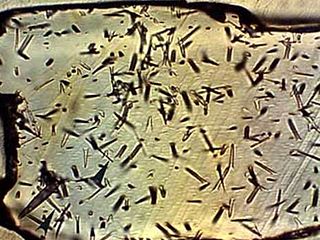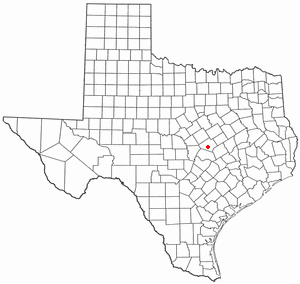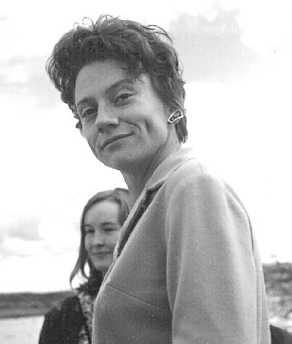
In the History of Mesoamerica, the stage known as the Paleo-Indian period is the era in the scheme of Mesoamerican chronology which begins with the very first indications of human habitation within the Mesoamerican region, and continues until the general onset of the development of agriculture and other proto-civilisation traits. The conclusion of this stage may be assigned to approximately 9000 BP, and the transition to the succeeding Archaic period is not a well-defined one.

Fission track dating is a radiometric dating technique based on analyses of the damage trails, or tracks, left by fission fragments in certain uranium-bearing minerals and glasses. Fission-track dating is a relatively simple method of radiometric dating that has made a significant impact on understanding the thermal history of continental crust, the timing of volcanic events, and the source and age of different archeological artifacts. The method involves using the number of fission events produced from the spontaneous decay of uranium-238 in common accessory minerals to date the time of rock cooling below closure temperature. Fission tracks are sensitive to heat, and therefore the technique is useful at unraveling the thermal evolution of rocks and minerals. Most current research using fission tracks is aimed at: a) understanding the evolution of mountain belts; b) determining the source or provenance of sediments; c) studying the thermal evolution of basins; d) determining the age of poorly dated strata; and e) dating and provenance determination of archeological artifacts.
Roald Hilding Fryxell was an American educator, geologist and archaeologist. He was a Professor of Anthropology at Washington State University (WSU) and pioneer in the interdisciplinary field of geoarchaeology, with a career that involved work on monumental projects in North America and even outer space.

La Cotte de St Brelade is a Paleolithic site of early habitation in Saint Brélade, Jersey. Cotte means "cave" in Jèrriais. The cave is also known as Lé Creux ès Fées.

Fort Rock Cave was the site of the earliest evidence of human habitation in the US state of Oregon before the excavation of the Paisley Caves. Fort Rock Cave featured numerous well-preserved sagebrush sandals, ranging from 9,000 to 13,000 years old. The cave is located approximately 1.5 miles (2.4 km) west of Fort Rock near Fort Rock State Natural Area in Lake County. Fort Rock Cave was declared a National Historic Landmark in 1961, and added to the National Register of Historic Places in 1966.

Beifudi is an archaeological site and Neolithic village in Yi County, Hebei, China. The site, an area of 3 ha on the northern bank of the Yishui River, contains artifacts of a culture contemporaneous with the Cishan and Xinglongwa cultures of about 8000–7000 BP, two known Neolithic cultures east of the Taihang Mountains, and thus fills an archaeological gap between the two Northern Chinese cultures. The total excavated area is more than 1,200 square meters and the collection of neolithic findings at the site has been conducted in two phases.

Gatecliff Rockshelter (26NY301) is a major archaeological site in the Great Basin area of the western United States that provides remarkable stratigraphy; it has been called the "deepest archaeological rock shelter in the Americas". Located in Mill Canyon of the Toquima Range in the Monitor Valley of central Nevada, Gatecliff Rockshelter has an elevation of 7,750 feet (2,360 m). David Hurst Thomas discovered Gatecliff Rockshelter in 1970 and began excavations in 1971. Full scale excavations occurred at Gatecliff Rockshelter for about seven field seasons in which nearly 33 feet (10 m) of sediments were exposed for a well-defined stratigraphic sequence. The well-preserved artifacts and undisturbed sediments at Gatecliff Rockshelter provides data and information have been applied to a range of research topics. Based on the analysis of the artifacts at Gatecliff Rockshelter, it can be determined that it was most likely a short-term field camp throughout prehistory. The latest evidence for human usage at Gatecliff occurs between ca. 5500 B.P. to 1250 B.P.

The Marmes Rockshelter is an archaeological site first excavated in 1962, near Lyons Ferry Park and the confluence of the Snake and Palouse Rivers, in Franklin County, southeastern Washington. This rockshelter is remarkable in the level of preservation of organic materials, the depth of stratified deposits, and the apparent age of the associated Native American human remains. The site was discovered on the property of Roland Marmes, and was the site of the oldest human remains in North America at that time. In 1966, the site became, along with Chinook Point and the American and English Camps on San Juan Island, the first National Historic Landmarks listed in Washington. In 1969, the site was submerged in water when a levee protecting it from waters rising behind the then newly constructed Lower Monumental Dam, which was 20 miles (32 km) down the Snake River, failed to hold back water that leaked into the protected area through gravel under the soil, creating Lake Herbert G. West.
Enkapune Ya Muto, also known as Twilight Cave, is a site spanning the late Middle Stone Age to the Late Stone Age on the Mau Escarpment of Kenya. This time span has allowed for further study of the transition from the Middle Stone Age to the Late Stone Age. In particular, the changes in lithic and pottery industries can be tracked over these time periods as well as transitions from a hunter-gatherer lifestyle to a herding lifestyle. Beads made of perforated ostrich egg shells found at the site have been dated to 40,000 years ago. The beads found at the site represent the early human use of personal ornaments. Inferences pertaining to climate and environment changes during the pre-Holocene and Holocene period have been made based from faunal remains based in this site.

The Lind Coulee Archaeological Site, also known as 45GR97, is the site of an archaeological dig near Warden, Washington. It dates to c. 11,000 cal BP.

The Windust Caves (45-FR-46) are a series of nine caves eroded into a basalt cliff on the north side of the lower Snake River in Franklin County, southeastern Washington. The caves were excavated from 1959 until 1961 by a crew led by Harvey S. Rice. The site contains cultural artifacts dating back over 10,000 years and is culturally associated with other sites in the Columbia Basin.

The LoDaisKa site is a prominent archaeological site in the U.S. state of Colorado, located within a rockshelter near Morrison. The rockshelter was first inhabited by people of the Archaic through the Middle Ceramic period, generally spanning 3000 BC to 1000 AD.
The Xalnene Tuff footprints are a geological academic controversy, concerning a 2005 discovery of 269 markings in a geological layer in the Valsequillo Basin, south of the city of Puebla, Mexico, which were originally interpreted to be human and animal footprints. The layer was variously dated to 40,000 years Before Present (BP) or 1.3 million years BP, both dates significantly before the currently accepted date for the settlement of the Americas. A 2010 study argues that the marks were made by recent mining activities.

The Buttermilk Creek complex is the remains of a paleolithic settlement along the shores of Buttermilk Creek in present-day Salado, Texas. The assemblage dates to ~13.2 to 15.5 thousand years old. If confirmed, the site represents evidence of human settlement in the Americas that pre-dates the Clovis culture.
Coxcatlan Cave is a Mesoamerican archaeological site in the Tehuacán Valley, State of Puebla, Mexico. It was discovered by Richard MacNeish in the 1960s during a survey of the Tehuacán Valley. It was the initial appearance of three domesticated plants in the Tehuacan Valley that allowed an evaluation to be done again of the overall temporal context of the plant domestication in Mexico. In addition to plants, Coxcatlan Cave also provided nearly 75 percent of the classified stone tools from excavation.

Cynthia Irwin-Williams was an archaeologist of the prehistoric American Southwest. She received a B.A. in Anthropology from Radcliffe College in 1957; the next year she received a M.A. in the same field. In 1963 she completed her educational career in Anthropology with a PhD. from Harvard University. Beginning her career in the 1950s, Irwin-Williams was considered a groundbreaker for women in archaeology, like her friend and supporter Hannah Marie Wormington.

The Gault archaeological site is an extensive, multicomponent site located in Florence, Texas, United States on the Williamson-Bell County line along Buttermilk Creek about 250 meters upstream from the Buttermilk Creek complex. It bears evidence of human habitation for at least 20,000 years, making it one of the few archaeological sites in the Americas at which compelling evidence has been found for human occupation dating to before the appearance of the Clovis culture. Archaeological material covers about 16 hectares with a depth of up to 3 meters in places. About 30 incised stones from the Clovis period engraved with geometric patterns were found there as well as others from periods up to the Early Archaic. Incised bone was also found.
Chronological dating, or simply dating, is the process of attributing to an object or event a date in the past, allowing such object or event to be located in a previously established chronology. This usually requires what is commonly known as a "dating method". Several dating methods exist, depending on different criteria and techniques, and some very well known examples of disciplines using such techniques are, for example, history, archaeology, geology, paleontology, astronomy and even forensic science, since in the latter it is sometimes necessary to investigate the moment in the past during which the death of a cadaver occurred. These methods are typically identified as absolute, which involves a specified date or date range, or relative, which refers to dating which places artifacts or events on a timeline relative to other events and/or artifacts. Other markers can help place an artifact or event in a chronology, such as nearby writings and stratigraphic markers.
The Riadino-5 Site is an archaeological site located on a terrace within the Šešupė River Valley in the Kaliningrad Oblast of the Russian Federation. Unlike most other sites near this area, the Riadino-5 site is one of the first sites of the Middle to Upper Paleolithic transitional period to have been found in the Baltic region, which includes Lithuania, Latvia, Estonia, and areas of the Russian Federation. Even when compared to other sites of similar age, the Riadino-5 site is still one of the northernmost sites to have been occupied in the Central European region. This makes it one of the oldest sites documenting human habitation, dating back all the way to the Marine Isotope Stage 3, approximately ca 57-26 thousand calendar years ago. The site itself was occupied during the Middle to Upper Paleolithic period within that era between 50 and 44 ka. Upon discovery, the site measured 200 meters by 80 meters. The approximate aging of the site was supported by findings of flint artifacts, using luminescence IRSL dating based on potassium-feldspar sample size and Carbon-14 dating of charcoal and ash layers from the site. At the moment, the exact culture and society of the site occupants has yet to be determined, and is currently undergoing comparative analysis to other similarly dated sites in the vicinity to uncover some answers.
The Scotts Valley Site (CA-SCAR-177), also known as the Lake Carbonera Site, is an archaeological site which has been documented as one of the oldest human settlement sites in Central California. Dated at 12,000-9,000 years before present, it is located in Scotts Valley, California, in the United States, at what was once a large pluvial lake.












